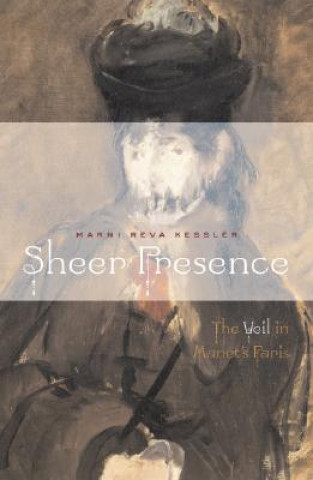
Kód: 04729959
Sheer Presence
Autor Marni Reva Kessler
Tamar's instrument of seduction in the Hebrew Bible, Penelope's shroud in Homer's Odyssey, accessory of brides as well as widows, and hallmark of the religious and the wealthy, the veil has historically been an intriguing signifie ... celý popis
- Jazyk:
 Angličtina
Angličtina - Vazba: Brožovaná
- Počet stran: 248
Nakladatelství: University of Minnesota Press, 2006
- Více informací o knize

Mohlo by se vám také líbit
-

Woman in Business
557 Kč -

Tramp Abroad
513 Kč -

Rock Garden in the South
810 Kč -

Regulating Older Drivers
561 Kč -

Tempests and Romantic Visionaries
1109 Kč -

Periplum and other poems
446 Kč -

Cairo
1017 Kč
Darujte tuto knihu ještě dnes
- Objednejte knihu a zvolte Zaslat jako dárek.
- Obratem obdržíte darovací poukaz na knihu, který můžete ihned předat obdarovanému.
- Knihu zašleme na adresu obdarovaného, o nic se nestaráte.
Více informací o knize Sheer Presence
Nákupem získáte 92 bodů
 Anotace knihy
Anotace knihy
Tamar's instrument of seduction in the Hebrew Bible, Penelope's shroud in Homer's Odyssey, accessory of brides as well as widows, and hallmark of the religious and the wealthy, the veil has historically been an intriguing signifier. Initially donned in France for liturgical purposes and later for masked balls and as a sun- and windscreen at the seashore, face-covering veils were adopted for fashionable urban use during the reign of Napoleon III. In Sheer Presence, Marni Reva Kessler demonstrates how this ubiquitous garment and its visual representations knot together many of the precepts of Parisian life. Considering the period from the beginning of Napoleon III's rule in 1852 to 1889, when the Paris Universal Exhibition displayed veiled North African Muslims and other indigenous colonial peoples, Kessler deftly connects the increased presence of the veil on the streets and on canvas to Haussmann's massive renovation of Paris. The fashion of veil wearing, she argues, was imbricated with broader concerns: fears of dust and disease fueled by Haussmannization and class mixing on the city streets, changes in ideals of youth and beauty, attempts to increase popular support for imperialism, and the development of modernist art practices. A veil was protection for the proper woman from the vices associated with the modern city, preserving--at least on the surface--her femininity and class superiority. Kessler explores these themes with close readings of paintings by Gustave Caillebotte, Edgar Degas, and Edouard Manet--including Manet's perplexing portraits of artist Berthe Morisot--as well as photographs, images from the popular press, engravings, lithographs, and academic paintings. She alsomines French fashion journals, etiquette books, novels, and medical publications for clues to the veil's complex meanings during the period. Positioning the veil directly at the intersection of feminist, formalist, and social art history, Kessler offers a fresh perspective
 Parametry knihy
Parametry knihy
Zařazení knihy Knihy v angličtině Society & social sciences Society & culture: general Cultural studies
922 Kč
- Plný název: Sheer Presence
- Podnázev: The Veil in Manet's Paris
- Autor: Marni Reva Kessler
- Jazyk:
 Angličtina
Angličtina - Vazba: Brožovaná
- Počet stran: 248
- EAN: 9780816647828
- ISBN: 0816647828
- ID: 04729959
- Nakladatelství: University of Minnesota Press
- Hmotnost: 399 g
- Rozměry: 229 × 150 × 14 mm
- Datum vydání: 11. December 2006
Oblíbené z jiného soudku
-

Sapiens
282 Kč -

All About Love
302 Kč -

Gastrophysics
323 Kč -

Berserk: With Darkness Ink
616 Kč -

Sand Talk: How Indigenous Thinking Can Save The World
484 Kč -

Electric Kool-Aid Acid Test
440 Kč -

Psychology of Harry Potter
539 Kč -

Origins and History of Consciousness
546 Kč -

Cigars: A Guide
706 Kč -

Self-Made Man
323 Kč -

Ghosts of My Life
388 Kč -

Art of Memory
517 Kč -

Esoteric Hollywood:: Sex, Cults and Symbols in Film
423 Kč -

Running the Gauntlet
789 Kč -

Pihkal
701 Kč -

Notes on Camp
89 Kč -

Psilocybin Magic Mushroom Guide
427 Kč -

Cosmos and Psyche
464 Kč -

Pimpology
381 Kč -

How to Invent Everything
706 Kč -

Medieval Costume and How to Recreate it
302 Kč -

Cultures and Organizations: Software of the Mind, Third Edition
809 Kč -

Reality is Broken
378 Kč -

Cannabis Breeder's Bible
476 Kč -

The Tipping Point
323 Kč -

Making of The Umbrella Academy
967 Kč -

Should We Eat Meat? - Evolution and Consequences of Modern Carnivory
1022 Kč -

Conquest of Bread
303 Kč -

Fashionable Nonsense
546 Kč -

Traditional American Tattoo Design
627 Kč -

You and I Eat the Same:
419 Kč -

Pure Invention
667 Kč -

Chaos and Cyber Culture
536 Kč -

Cozy Days
696 Kč -

Ways of Curating
302 Kč -

Danse Macabre
302 Kč -

Coddling of the American Mind
739 Kč -

Sekiro: The Second Life Of Souls
645 Kč -

Replay: the History of Video Games
674 Kč -

Defenders of the Faith
850 Kč -

Vogue Covers: On Fashion's Front Page
543 Kč -

Pragmatism and Other Writings
302 Kč -

Cambridge Companion to Modern British Culture
925 Kč -

Feast for the Eyes
1341 Kč -

Sleepwalkers
540 Kč -

Occult in Russian and Soviet Culture
1276 Kč -

Art of Zenescope Volume 2
2792 Kč -

MOD
410 Kč -

Cultural Policy
1048 Kč
Osobní odběr Praha, Brno a 12903 dalších
Copyright ©2008-24 nejlevnejsi-knihy.cz Všechna práva vyhrazenaSoukromíCookies



 Vrácení do měsíce
Vrácení do měsíce 571 999 099 (8-15.30h)
571 999 099 (8-15.30h)